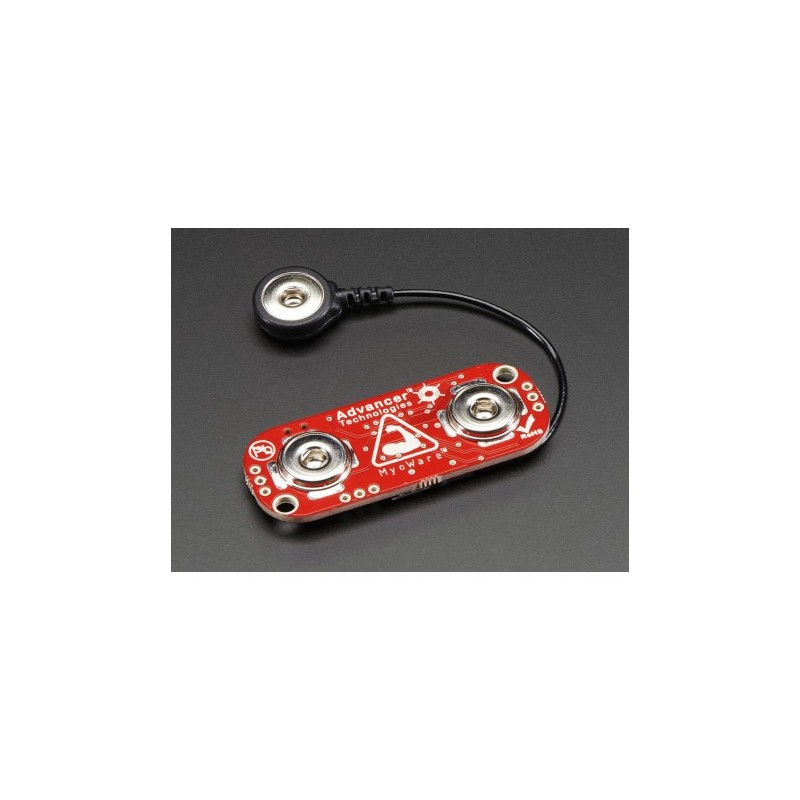- Out-of-Stock





Have your next project be controlled by your muscles with the MyoWare Muscle Sensor! Pair the MyoWare with some Muscle Sensor Surface EMG Electrodes and a microcontroller (ie. Raspberry Pi, Arduino, or Beagle Bone Black) to create a DIY low-cost version of an EMG or an electromyograph!
Electromyography is an electrodiagnostic medicine technique for evaluating and recording the electrical activity produced by skeletal muscles. Use these sensors in prosthetics, robotics, and so much more! Once you attach the sensor to a large muscle (like your bicep) you can flex and measure the signal spike as an analog voltage.
These MyoWare Muscle Sensors are designed to be used by hobbyists, backyard tinkerers, and students alike. Check the datasheet for more information and both setup configurations as well as setup instructions.
Note!
This product does not include electrodes; they are available separately in packs of six. To use the sensor, an electrode must be connected to each of the sensor’s three snap connectors (two on the PCB and the third at the end of the black reference electrode cable).This muscle sensor from Advancer Technologies measures a muscle’s activity by monitoring the electric potential generated by muscle cells. This is referred to as electromyography (EMG). The sensor amplifies and processes the complex electrical activity of a muscle and converts it into a simple analog signal that can easily be read by any microcontroller with an analog-to-digital converter (ADC), such as an A-Star or Arduino – or even a Maestro servo controller like we show in this blog post. As the target muscle group flexes, the sensor’s output voltage increases. The exact relationship between the output voltage and the muscle activity can be fine-tuned using an on-board gain potentiometer.
The MyoWare Muscle Sensor is an updated version of Advancer Technologies’ older Muscle Sensor v3 with a number of improvements, notably single-supply operation (no need for a negative voltage supply) and built-in snap connectors for electrodes. Other new features include a raw EMG output, reverse power protection, a power switch, and LED indicators.
In order to attach to skin, the sensor requires three electrodes (not included) that snap into the sensor’s snap-style connectors, which make it easy to attach and detach electrodes. Two connectors are located directly on the PCB, and the third is located at the end of the attached reference electrode cable. The board’s pins have a 0.1″ pitch and work with 0.1″ male headers and 0.1″ female headers.
Code: Pololu 2732, Adafruit 2699
Manufacturer BTC Korporacja sp. z o. o. Lwowska 5 05-120 Legionowo Poland sprzedaz@kamami.pl 22 767 36 20
Responsible person BTC Korporacja sp. z o. o. Lwowska 5 05-120 Legionowo Poland sprzedaz@kamami.pl 22 767 36 20
Muscle Sensor Surface EMG Electrodes allow you to control your projects with your muscles. Adafruit 2773
No product available!
The MyoWare Power Shield is designed to take two standard CR2032 coin cell batteries to power the MyoWare Muscle Sensor. We have made this board in a way that the coin cell batteries are connected in parallel for extended capacity at a nominal 3.0V. DEV-13684
No product available!
Module with 3.5 mm TRS connector for MyoWare 2.0 muscle tension sensors. It allows you to conveniently connect the sensors with the development board via the Arduino shield. SparkFun DEV-18386
Development kit for ST7FLITE3x microcontrollers
No product available!
EDUCATIONAL EDUCATIONAL MACHINE WITH 8051 (MAIN BOARD) - PLATEBOARD AND PROGRAMMED LAYOUT
No product available!
No product available!
No product available!
No product available!
No product available!
RLink-STD is a versatile programmer and debugger for STM8 and ARM microcontrollers, enabling unlimited programming and partial application debugging in the Ride7 environment. It supports JTAG, SWD, SWIM, and ICC, making it a suitable tool for working with a wide range of embedded systems.
No product available!
No product available!
Pre-assembled precision timer 1 second-99 minutes. AVT1995 C
No product available!
AVT set for self-assembly of screw-on timer with acoustic siren. AVT3143 B
No product available!
No product available!
No product available!
No product available!
LITEcompLPC1114 - Module added to the book "LPC1100 microcontrollers. Getting Started"
No product available!
No product available!
AVT kit for self-assembly of an adjustable symmetrical voltage supply. AVT1882 B
No product available!

The MyoWare Muscle Sensor measures, filters, rectifies, and amplifies the electrical activity of a muscle and produces an analog output signal that can easily be read by a microcontroller, enabling novel, muscle-controlled interfaces for your projects.
